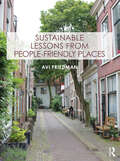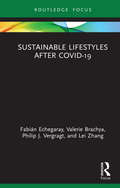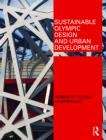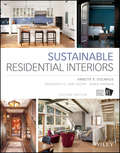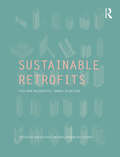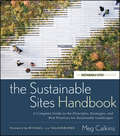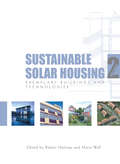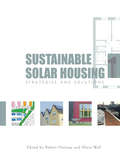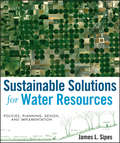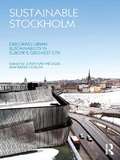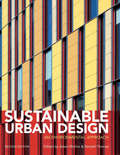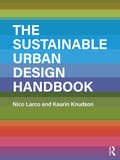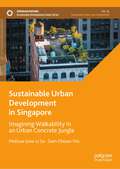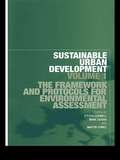- Table View
- List View
Sustainable Lessons from People-Friendly Places
by Avi FriedmanCurrent planning and design modes of cities are facing challenges of philosophy and form. Past approaches no longer sustain new demands and call for innovative thinking. In a world that is becoming highly urbanized, the need for a new outlook is propelled by fundamental global changes that touch upon environmental, economic and social aspects.The book introduces fundamental principles of timely sustainable urban design, paying attention to architecture, integration of natural features, public urban spaces and their successful use. Readers will learn how cities are transitioning to active mobility by placing the wellbeing of citizens at the heart of planning; making buildings fit nature; supporting local culture through preservation; and including community gardens in neighborhoods, among others. Written by a practicing architect, professor and author, the book is richly illustrated and features meticulously selected international case studies.
Sustainable Lifestyles after Covid-19 (Routledge-SCORAI Studies in Sustainable Consumption)
by Fabián Echegaray Valerie Brachya Philip J. Vergragt Lei ZhangThis book takes an in-depth look at Covid-19-generated societal trends and develops scenarios for possible future directions of urban lifestyles. Drawing on examples from Brazil, China, and Israel, and with a particular focus on cities, this book explores the short and long-term changes in individual consumers and citizen behavior as a result of the Covid-19 pandemic. On the basis of extensive market and opinion research data, aggregate data, observational evidence, and news reports, the authors provide a detailed account of the transformations that have occurred as a result of a triple shock of public health emergency, economic shutdown, and social isolation. They also examine which of these behavioral changes are likely to become permanent and consider whether this may ultimately promote or restrain sustainable lifestyle choices. Innovative and timely, this book will be of great interest to students, scholars, and professionals researching and working in the areas of sustainable consumption, urban and land use planning, and public health.
Sustainable Lifestyles after Covid-19 (Routledge-SCORAI Studies in Sustainable Consumption)
by Fabián Echegaray Valerie Brachya Philip J. Vergragt Lei ZhangThis book takes an in-depth look at Covid-19-generated societal trends and develops scenarios for possible future directions of urban lifestyles. Drawing on examples from Brazil, China, and Israel, and with a particular focus on cities, this book explores the short and long-term changes in individual consumers and citizen behavior as a result of the Covid-19 pandemic. On the basis of extensive market and opinion research data, aggregate data, observational evidence, and news reports, the authors provide a detailed account of the transformations that have occurred as a result of a triple shock of public health emergency, economic shutdown, and social isolation. They also examine which of these behavioral changes are likely to become permanent and consider whether this may ultimately promote or restrain sustainable lifestyle choices. Innovative and timely, this book will be of great interest to students, scholars, and professionals researching and working in the areas of sustainable consumption, urban and land use planning, and public health.
Sustainable Olympic Design and Urban Development (PDF)
by Adrian Pitts Hanwen LiaoThis book explains how a modern Olympic Games can successfully develop a more sustainable design approach by learning from the lessons of the past and by taking account of the latest developments. The text focuses at two levels: one is at the strategic planning level of whether and how Olympic intervention can transform the host city into a more sustainable urban form; the other is on the measures applicable to individual Olympic projects which can be taken to reduce the resource usage and lower the environmental impacts during their procurement and maintenance. It offers an assessment tool that can be tailored to individual circumstance – a tool which emerges from the analysis of previous Summer Games’ host cities and from techniques in environmental analysis and assessment. The work demonstrates that with appropriate planning and design, Olympic urban development has the potential to leave positive environmental legacies to the host city and contribute to environmental sustainability. The environmental performance and effects of Olympic schemes can be judged, and hence improved, by applying appropriate evaluation systems to them. By these means, ‘green’ Olympic development can be pursued in a more meaningful and controllable way.
Sustainable Residential Interiors
by Annette Stelmack Associates III Kari Foster Debbie HindmanThe Second Edition of Sustainable Residential Interiors addresses cutting edge processes, strategies, and principles as well as details for in-depth product vetting criteria. Award-winning, leading interior designer Annette Stelmack shares her expertise from the perspective of LEED Building Design & Construction projects, healthy interiors, and chemical sensitivities, addressing principles, strategies, and solutions for design practitioners. A comprehensive update of the current state of the sustainable interior design industry is provided, including present and upcoming industry transformations, thought-leading principles, strategies and practices for project implementation, and fine points and resources for in-depth product vetting to support high-performing, healthy interiors. Sustainable Residential Interiors takes readers through an integrated design process, demonstrating relevant principles and practices that apply to essentially any interiors project toward creating an environment that is healthy, high-performing, functional, sustainable, and beautiful. In doing so, it: Promotes critical thinking about health and environmental issues in the building industry Features checklists and current resources, providing a "hands on" practical approach Addresses in-depth, applicable third party certifications and details on relevant building rating systems Provides in-depth strategies and criteria for fixed interior finishes, fixtures, equipment and furnishings Demonstrates successful, relevant, diverse and inspiring case studies Delivers comprehensive tools and resources for researching and vetting products' composition and chemical make-up. Evaluates all aspects of a building's interior to identify and implement methods that: save energy and water; reduce Co2 emissions and waste; improve indoor air quality free of toxins; and are responsive to environmental impacts Encourages forward-thinking by featuring inspirational statements from mentors, peers, and industry leaders Urges interior designers to commit to designing safe, healthy environments that are integral to a professional code of ethics, which ensure the delivery of positive outcomes for the client and any building's future occupants
Sustainable Residential Interiors
by Annette Stelmack Associates III Kari Foster Debbie HindmanThe Second Edition of Sustainable Residential Interiors addresses cutting edge processes, strategies, and principles as well as details for in-depth product vetting criteria. Award-winning, leading interior designer Annette Stelmack shares her expertise from the perspective of LEED Building Design & Construction projects, healthy interiors, and chemical sensitivities, addressing principles, strategies, and solutions for design practitioners. A comprehensive update of the current state of the sustainable interior design industry is provided, including present and upcoming industry transformations, thought-leading principles, strategies and practices for project implementation, and fine points and resources for in-depth product vetting to support high-performing, healthy interiors. Sustainable Residential Interiors takes readers through an integrated design process, demonstrating relevant principles and practices that apply to essentially any interiors project toward creating an environment that is healthy, high-performing, functional, sustainable, and beautiful. In doing so, it: Promotes critical thinking about health and environmental issues in the building industry Features checklists and current resources, providing a "hands on" practical approach Addresses in-depth, applicable third party certifications and details on relevant building rating systems Provides in-depth strategies and criteria for fixed interior finishes, fixtures, equipment and furnishings Demonstrates successful, relevant, diverse and inspiring case studies Delivers comprehensive tools and resources for researching and vetting products' composition and chemical make-up. Evaluates all aspects of a building's interior to identify and implement methods that: save energy and water; reduce Co2 emissions and waste; improve indoor air quality free of toxins; and are responsive to environmental impacts Encourages forward-thinking by featuring inspirational statements from mentors, peers, and industry leaders Urges interior designers to commit to designing safe, healthy environments that are integral to a professional code of ethics, which ensure the delivery of positive outcomes for the client and any building's future occupants
Sustainable Retrofits: Post War Residential Towers in Britain
by Asterios Agkathidis Rosa Urbano GutiérrezPresenting the state-of-the-art in sustainable retrofits in post war residential towers, this book captures and re-informs the current intense refurbishing process that is taking place in Britain, which is part of a global phenomenon happening all over the world, as cities upgrade their building stock in an attempt to comply with governmental emission reduction targets. The authors present inspections of 20 sustainably retrofitted social housing towers, analysing their aesthetic and technical modifications, as well as the shifts occurring in their social structure. The authors use over 200 full colour plans, elevations, photographs, maps and illustrations to beautifully support the statistical and analytical information collected. Finally they include interviews with some of the architects who designed the retrofits, residents and key stakeholders to inform the conclusions.
Sustainable Retrofits: Post War Residential Towers in Britain
by Asterios Agkathidis Rosa Urbano GutiérrezPresenting the state-of-the-art in sustainable retrofits in post war residential towers, this book captures and re-informs the current intense refurbishing process that is taking place in Britain, which is part of a global phenomenon happening all over the world, as cities upgrade their building stock in an attempt to comply with governmental emission reduction targets. The authors present inspections of 20 sustainably retrofitted social housing towers, analysing their aesthetic and technical modifications, as well as the shifts occurring in their social structure. The authors use over 200 full colour plans, elevations, photographs, maps and illustrations to beautifully support the statistical and analytical information collected. Finally they include interviews with some of the architects who designed the retrofits, residents and key stakeholders to inform the conclusions.
The Sustainable Sites Handbook: A Complete Guide to the Principles, Strategies, and Best Practices for Sustainable Landscapes (Wiley Series In Sustainable Design Ser.)
by Meg CalkinsGet the definitive resource guide for sustainable site design, construction, and management. The Sustainable Sites Initiative (SITES) is transforming land design, development, and management practices across the United States with the first national rating system for sustainable landscapes. The Sustainable Sites Handbook features comprehensive and detailed information on principles, strategies, technologies, tools, and best practices for sustainable site design. Contributors to this book are some of the same experts that carefully shaped the SITES rating tool, ensuring thorough coverage of the broad range of topics related to sustainable site design. The Sustainable Sites Handbook offers in-depth coverage of design, construction, and management for systems of hydrology, vegetation, soils, materials, and human health and well-being. Focusing primarily on environmental site design and ecosystem services, this wide-ranging guide also covers issues of social equity, economic feasibility, and stewardship, which are crucial to the success of any sustainable site. Equally useful as a handbook for obtaining SITES credits or for the independent development of sustainable sites, The Sustainable Sites Handbook is an indispensible resource for practicing professionals in landscape architecture, landscape design, architecture, civil engineering, land planning, horticulture, ecology, environmental engineering, landscape contracting, and parks and recreation management.
The Sustainable Sites Handbook: A Complete Guide to the Principles, Strategies, and Best Practices for Sustainable Landscapes
by Meg CalkinsGet the definitive resource guide for sustainable site design, construction, and management. The Sustainable Sites Initiative (SITES) is transforming land design, development, and management practices across the United States with the first national rating system for sustainable landscapes. The Sustainable Sites Handbook features comprehensive and detailed information on principles, strategies, technologies, tools, and best practices for sustainable site design. Contributors to this book are some of the same experts that carefully shaped the SITES rating tool, ensuring thorough coverage of the broad range of topics related to sustainable site design. The Sustainable Sites Handbook offers in-depth coverage of design, construction, and management for systems of hydrology, vegetation, soils, materials, and human health and well-being. Focusing primarily on environmental site design and ecosystem services, this wide-ranging guide also covers issues of social equity, economic feasibility, and stewardship, which are crucial to the success of any sustainable site. Equally useful as a handbook for obtaining SITES credits or for the independent development of sustainable sites, The Sustainable Sites Handbook is an indispensible resource for practicing professionals in landscape architecture, landscape design, architecture, civil engineering, land planning, horticulture, ecology, environmental engineering, landscape contracting, and parks and recreation management.
Sustainable Solar Housing: Volume 2 - Exemplary Buildings and Technologies
by Robert S. Hastings Maria WallThis far-reaching and authoritative two-volume set examines a range of potential solutions for low-energy building design, considering different strategies (energy conservation and renewable energy) and technologies (relating to the building envelope, ventilation, heat delivery, heat production, heat storage, electricity and control). Energy and life-cycle impacts are considered as crucial factors, including passive and active solar use, daylighting and high efficiency conventional heat production. Each volume assesses the potential of these options in a variety of contexts, covering different housing types (apartment, row and detached) in cold, temperate and mild climates. The impressive list of expert authors from 14 countries includes a mix of internationally respected academics and practitioners, working together within the framework of a five-year International Energy Agency (IEA) research project. Volume 1 presents strategies and solutions, offering the reader a solid basis for developing concepts, considering environmental and economic concerns for housing projects in a variety of contexts. Volume 2 offers a detailed analysis of exemplary buildings in different European countries and examines the various technologies employed to achieve their remarkable performance. Aided by clear, full colour illustrations, it offers invaluable insights into the application of these technologies.
Sustainable Solar Housing: Volume 1 - Strategies and Solutions
by Robert S. Hastings Maria WallThis far-reaching and authoritative two-volume set examines a range of potential solutions for low-energy building design, considering different strategies (energy conservation and renewable energy) and technologies (relating to the building envelope, ventilation, heat delivery, heat production, heat storage, electricity and control). Energy and life-cycle impacts are considered as crucial factors, including passive and active solar use, daylighting and high efficiency conventional heat production. Each volume assesses the potential of these options in a variety of contexts, covering different housing types (apartment, row and detached) in cold, temperate and mild climates. The impressive list of expert authors from 14 countries includes a mix of internationally respected academics and practitioners, working together within the framework of a five-year International Energy Agency (IEA) research project. Volume 1 presents strategies and solutions, offering the reader a solid basis for developing concepts, considering environmental and economic concerns for housing projects in a variety of contexts. Volume 2 offers a detailed analysis of exemplary buildings in different European countries and examines the various technologies employed to achieve their remarkable performance. Aided by clear, full colour illustrations, it offers invaluable insights into the application of these technologies.
Sustainable Solar Housing: Volume 2 - Exemplary Buildings and Technologies
by Robert Hastings Maria WallThis far-reaching and authoritative two-volume set examines a range of potential solutions for low-energy building design, considering different strategies (energy conservation and renewable energy) and technologies (relating to the building envelope, ventilation, heat delivery, heat production, heat storage, electricity and control). Energy and life-cycle impacts are considered as crucial factors, including passive and active solar use, daylighting and high efficiency conventional heat production. Each volume assesses the potential of these options in a variety of contexts, covering different housing types (apartment, row and detached) in cold, temperate and mild climates. The impressive list of expert authors from 14 countries includes a mix of internationally respected academics and practitioners, working together within the framework of a five-year International Energy Agency (IEA) research project. Volume 1 presents strategies and solutions, offering the reader a solid basis for developing concepts, considering environmental and economic concerns for housing projects in a variety of contexts. Volume 2 offers a detailed analysis of exemplary buildings in different European countries and examines the various technologies employed to achieve their remarkable performance. Aided by clear, full colour illustrations, it offers invaluable insights into the application of these technologies.
Sustainable Solar Housing: Volume 1 - Strategies and Solutions
by S. Robert Hastings Maria WallThis far-reaching and authoritative two-volume set examines a range of potential solutions for low-energy building design, considering different strategies (energy conservation and renewable energy) and technologies (relating to the building envelope, ventilation, heat delivery, heat production, heat storage, electricity and control). Energy and life-cycle impacts are considered as crucial factors, including passive and active solar use, daylighting and high efficiency conventional heat production. Each volume assesses the potential of these options in a variety of contexts, covering different housing types (apartment, row and detached) in cold, temperate and mild climates. The impressive list of expert authors from 14 countries includes a mix of internationally respected academics and practitioners, working together within the framework of a five-year International Energy Agency (IEA) research project. Volume 1 presents strategies and solutions, offering the reader a solid basis for developing concepts, considering environmental and economic concerns for housing projects in a variety of contexts. Volume 2 offers a detailed analysis of exemplary buildings in different European countries and examines the various technologies employed to achieve their remarkable performance. Aided by clear, full colour illustrations, it offers invaluable insights into the application of these technologies.
Sustainable Solutions for Water Resources: Policies, Planning, Design, and Implementation
by James L. SipesGet the single-source solutions guide to the sustainable management of water resources. Why is water the environmental issue? The answer is simple: without it, life on this planet could not exist. Yet, despite this fact, reckless consumption practices from a growing population are drying up the Earth's already limited water resources. Other factors, such as river and lake contamination, rising temperatures, and disproportionate geographic accessibility further contribute to the fresh water crisis. To confront this pressing concern, this enlightening guide, which covers over twenty case studies offering insights into real-world projects, uses a holistic, integrated approach to illustrate ways to preserve vital water supplies -- from green design remedies to encouraging greater personal responsibility. This book: Provides a basic overview of water resources, hydrology, current problems involving water resources, and the potential impact of global warming and climate change. Covers watershed planning, Best Management Practices, and potential design and planning solutions. Offers a concise overview of the issues affecting water use and management. Includes a full chapter dedicated to planning issues, and a full chapter covering site planning, design, and implementation. Sustainable Solutions for Water Resources takes a practical approach to head off a global water catastrophe by offering sensible measures that can be put in place immediately to promote a clean, plentiful flow of the Earth's most precious resource.
Sustainable Solutions for Water Resources: Policies, Planning, Design, and Implementation
by James L. SipesGet the single-source solutions guide to the sustainable management of water resources. Why is water the environmental issue? The answer is simple: without it, life on this planet could not exist. Yet, despite this fact, reckless consumption practices from a growing population are drying up the Earth's already limited water resources. Other factors, such as river and lake contamination, rising temperatures, and disproportionate geographic accessibility further contribute to the fresh water crisis. To confront this pressing concern, this enlightening guide, which covers over twenty case studies offering insights into real-world projects, uses a holistic, integrated approach to illustrate ways to preserve vital water supplies -- from green design remedies to encouraging greater personal responsibility. This book: Provides a basic overview of water resources, hydrology, current problems involving water resources, and the potential impact of global warming and climate change. Covers watershed planning, Best Management Practices, and potential design and planning solutions. Offers a concise overview of the issues affecting water use and management. Includes a full chapter dedicated to planning issues, and a full chapter covering site planning, design, and implementation. Sustainable Solutions for Water Resources takes a practical approach to head off a global water catastrophe by offering sensible measures that can be put in place immediately to promote a clean, plentiful flow of the Earth's most precious resource.
Sustainable Stockholm: Exploring Urban Sustainability in Europe’s Greenest City
by Jonathan Metzger Amy Rader OlssonSustainable Stockholm provides a historical overview of Stockholm’s environmental development, and also discusses a number of cross-disciplinary themes presenting the urban sustainability work behind Stockholm’s unique position, and importantly the question of how well Stockholm’s practices can be exported and transposed to other places and contexts. By using the case of Stockholm as the pivot of discussions, Sustainable Stockholm investigates the core issues of sustainable urban environmental development and planning, in all their entanglements. The book shows how intersecting fields such as urban planning and architecture, traffic planning, land-use regulation, building, waste management, regional development, water management, infrastructure engineering—together and in combination—have contributed to making Stockholm Europe’s "greenest" city.
Sustainable Stockholm: Exploring Urban Sustainability in Europe’s Greenest City
by Jonathan Metzger Amy Rader OlssonSustainable Stockholm provides a historical overview of Stockholm’s environmental development, and also discusses a number of cross-disciplinary themes presenting the urban sustainability work behind Stockholm’s unique position, and importantly the question of how well Stockholm’s practices can be exported and transposed to other places and contexts. By using the case of Stockholm as the pivot of discussions, Sustainable Stockholm investigates the core issues of sustainable urban environmental development and planning, in all their entanglements. The book shows how intersecting fields such as urban planning and architecture, traffic planning, land-use regulation, building, waste management, regional development, water management, infrastructure engineering—together and in combination—have contributed to making Stockholm Europe’s "greenest" city.
Sustainable Urban Design: An Environmental Approach
by Adam Ritchie Randall ThomasBy the end of the twenty-first century it is thought that three-quarters of the world’s population will be urban; our future is in cities. Making these cities healthy, vibrant and sustainable is an exceptional challenge which this book addresses. It sets out some of the basic principles of the design of our future cities and, through a series of carefully-selected case studies from leading designers’ experience, illustrates how these ideas can be put into practice. Building on the first edition's original format of design guidance and case studies, this new edition updates the ideas and techniques resulting from further research and practice by the contributors. This book emphasises the enormous progress made towards exciting new designs that integrate good design with resource efficiency.
Sustainable Urban Design: An Environmental Approach
by Adam Ritchie Randall ThomasBy the end of the twenty-first century it is thought that three-quarters of the world’s population will be urban; our future is in cities. Making these cities healthy, vibrant and sustainable is an exceptional challenge which this book addresses. It sets out some of the basic principles of the design of our future cities and, through a series of carefully-selected case studies from leading designers’ experience, illustrates how these ideas can be put into practice. Building on the first edition's original format of design guidance and case studies, this new edition updates the ideas and techniques resulting from further research and practice by the contributors. This book emphasises the enormous progress made towards exciting new designs that integrate good design with resource efficiency.
The Sustainable Urban Design Handbook
by Nico Larco Kaarin KnudsonThe Sustainable Urban Design Handbook gathers the best sustainability practices and latest research from the fields of architecture, landscape architecture, planning, development, ecology, and environmental engineering and presents them in a graphically rich and accessible format that can help guide urban design decisions in cities of all sizes.The book presents a comprehensive framework that organizes more than 50 elements of sustainable urban design under five main topics–Energy Use & Greenhouse Gas, Water, Ecology & Habitat, Energy Use & Production, and Equity & Health–and relative to four project scales: Region & City, District & Neighborhood, Block & Street, and Project & Parcel. Each element chapter includes a summary of importance and background, compares typical practices and recommended approaches, explains connections to other elements, and concludes with urban design guidelines that can be used to directly inform projects and decisions.Easy to use and reference, The Sustainable Urban Design Handbook provides both an in-depth introduction to topics across sustainable urban design and serves as an on-going reference for anyone involved in the creation of sustainable urban environments. This resource will be useful to design and planning professionals, community members, students, and elected officials in guiding decisions about our sustainable future.
The Sustainable Urban Design Handbook
by Nico Larco Kaarin KnudsonThe Sustainable Urban Design Handbook gathers the best sustainability practices and latest research from the fields of architecture, landscape architecture, planning, development, ecology, and environmental engineering and presents them in a graphically rich and accessible format that can help guide urban design decisions in cities of all sizes.The book presents a comprehensive framework that organizes more than 50 elements of sustainable urban design under five main topics–Energy Use & Greenhouse Gas, Water, Ecology & Habitat, Energy Use & Production, and Equity & Health–and relative to four project scales: Region & City, District & Neighborhood, Block & Street, and Project & Parcel. Each element chapter includes a summary of importance and background, compares typical practices and recommended approaches, explains connections to other elements, and concludes with urban design guidelines that can be used to directly inform projects and decisions.Easy to use and reference, The Sustainable Urban Design Handbook provides both an in-depth introduction to topics across sustainable urban design and serves as an on-going reference for anyone involved in the creation of sustainable urban environments. This resource will be useful to design and planning professionals, community members, students, and elected officials in guiding decisions about our sustainable future.
Sustainable Urban Development in Singapore: Imagining Walkability in an Urban Concrete Jungle (Sustainable Development Goals Series)
by Melissa Liow Li Sa Sam Choon-YinThis book offers theoretical and practical insights into land use, transport, and national policies in one of world’s well-known urban concrete jungle, none other than the Singapore city. The emphasis is situated on Singapore’s attempt to promote walking and cycling. Greater appreciation of walkability thrives on Singapore’s rich history, green city, people and the gastronomic kopitiam and hawker culture. The book offers a comprehensive coverage of walkability as a crucial component of urban design to reduce vehicular congestion with the associated carbon emissions, foster a healthy lifestyle and community participation and create jobs to help the economy. A high income per capita and an aging society, lessons drawn from Singapore’s experience will be useful to other societies. Scholars in sustainable tourism field, urban planners, government bodies, tourist boards, entrepreneurs, national parks board, residents, and inbound travellers will benefit from reading the book.
Sustainable Urban Development Volume 1: The Framework and Protocols for Environmental Assessment (Sustainable Urban Development Series)
by Stephen Curwell Mark Deakin Martin SymesBased on original research, this first volume of a set of groundbreaking new books sets out a framework for analyzing sustainable urban development and develops a set of protocols for evaluating the sustainability of urban development. Protocols included are for sustainable urban planning, urban property development, urban design, the construction, operation and use of buildings. Using these protocols, the book goes on to provide a directory of environmental assessment methods for evaluating the sustainability of urban development and also maps out how these assessment methods are being transformed to evaluate the environmental, economic and social sustainability of urban development. Web-based applications are increasingly being used to support this transformation and the contributors deftly cover this application and issues concerning the use of information and communication technologies for evaluating the sustainability of urban development are also dealt with. With its multidisciplinary approach, Sustainable Urban Development presents key new material for postgraduates and professionals across the built environment.
Sustainable Urban Development Volume 1: The Framework and Protocols for Environmental Assessment (Sustainable Urban Development Series #Vol. 1)
by Steven Curwell Mark Deakin Martin SymesBased on original research, this first volume of a set of groundbreaking new books sets out a framework for analyzing sustainable urban development and develops a set of protocols for evaluating the sustainability of urban development. Protocols included are for sustainable urban planning, urban property development, urban design, the construction, operation and use of buildings. Using these protocols, the book goes on to provide a directory of environmental assessment methods for evaluating the sustainability of urban development and also maps out how these assessment methods are being transformed to evaluate the environmental, economic and social sustainability of urban development. Web-based applications are increasingly being used to support this transformation and the contributors deftly cover this application and issues concerning the use of information and communication technologies for evaluating the sustainability of urban development are also dealt with. With its multidisciplinary approach, Sustainable Urban Development presents key new material for postgraduates and professionals across the built environment.
